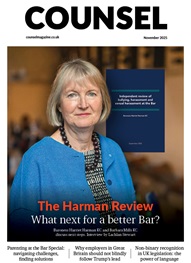*/
Women made up almost half of those recommended for appointment to the Bench last year, but fewer than 10% came from an ethnic minority background, statistics from the Judicial Appointments Commission (JAC) revealed.
Of the 308 recommendations made between 1 April 2015 and 31 March 2016, 140 (45%) were women and only 28 (9%) declared themselves to be from an ethnic minority, while nine (3%) said they had a disability.
Of the of 21 recommendations made for senior posts – above the level of the High Court – only four (19%) were women.
Looking at the recommendations for Recorders – the first rung on the ladder to a full-time judicial career – the Bar Council calculated that white applicants were three times more likely to succeed than candidates from a minority ethnic group.
Sam Mercer, head of equality and diversity at the Bar Council, said: ‘At every stage of the process, BAME [black and minority ethnic] applicants did less well than their white colleagues.
‘If you are a white lawyer applying to become a Recorder you have a one in 10 chance of success. If you belong to a minority ethnic group, that drops to one in 33.’
Mercer said: ‘This inequality is unacceptable. We urgently need to work in partnership with organisations across the legal sector, and with government, to find out why this distortion is occurring and take immediate measures for correction.’
She added: ‘Those appointed as Recorders make up the pool from which the ranks of the senior judiciary are drawn. Lack of diversity at this level has huge implications for the ethnic make-up of our most influential and respected tier of public servants.’
Mercer also noted that since 2012, there have been no BAME applications or appointments at all to the Court of Appeal and there are still no BAME judges in the Supreme Court.
The JAC statistics revealed that the equal merit provision, which has been available for all exercises since July 2015, was used in 14 instances during the reporting period.
The provision means that, in a selection exercise where there are two or more candidates of equal merit, a candidate may be selected for a post for the purpose of increasing judicial diversity.
Women made up almost half of those recommended for appointment to the Bench last year, but fewer than 10% came from an ethnic minority background, statistics from the Judicial Appointments Commission (JAC) revealed.
Of the 308 recommendations made between 1 April 2015 and 31 March 2016, 140 (45%) were women and only 28 (9%) declared themselves to be from an ethnic minority, while nine (3%) said they had a disability.
Of the of 21 recommendations made for senior posts – above the level of the High Court – only four (19%) were women.
Looking at the recommendations for Recorders – the first rung on the ladder to a full-time judicial career – the Bar Council calculated that white applicants were three times more likely to succeed than candidates from a minority ethnic group.
Sam Mercer, head of equality and diversity at the Bar Council, said: ‘At every stage of the process, BAME [black and minority ethnic] applicants did less well than their white colleagues.
‘If you are a white lawyer applying to become a Recorder you have a one in 10 chance of success. If you belong to a minority ethnic group, that drops to one in 33.’
Mercer said: ‘This inequality is unacceptable. We urgently need to work in partnership with organisations across the legal sector, and with government, to find out why this distortion is occurring and take immediate measures for correction.’
She added: ‘Those appointed as Recorders make up the pool from which the ranks of the senior judiciary are drawn. Lack of diversity at this level has huge implications for the ethnic make-up of our most influential and respected tier of public servants.’
Mercer also noted that since 2012, there have been no BAME applications or appointments at all to the Court of Appeal and there are still no BAME judges in the Supreme Court.
The JAC statistics revealed that the equal merit provision, which has been available for all exercises since July 2015, was used in 14 instances during the reporting period.
The provision means that, in a selection exercise where there are two or more candidates of equal merit, a candidate may be selected for a post for the purpose of increasing judicial diversity.


The Bar Council continues to call for investment for the justice system and represent the interests of our profession both at home and abroad
By Marie Law, Director of Toxicology at AlphaBiolabs
AlphaBiolabs has made a £500 donation to Sean’s Place, a men’s mental health charity based in Sefton, as part of its ongoing Giving Back initiative
Q&A with Tim Lynch of Jordan Lynch Private Finance
By Marie Law, Director of Toxicology at AlphaBiolabs
By Louise Crush of Westgate Wealth Management
Little has changed since Burns v Burns . Cohabiting couples deserve better than to be left on the blasted heath with the existing witch’s brew for another four decades, argues Christopher Stirling
Six months of court observation at the Old Bailey: APPEAL’s Dr Nisha Waller and Tehreem Sultan report their findings on prosecution practices under joint enterprise
The Amazonian artist’s first international solo exhibition is wholly relevant to current issues in social and environmental justice, says Stephen Cragg KC
Despite its prevalence, autism spectrum disorder remains poorly understood in the criminal justice system. Does Alex Henry’s joint enterprise conviction expose the need to audit prisons? asks Dr Felicity Gerry KC
It’s been five years since the groundbreaking QC competition in which six Black women barristers, including the 2025 Chair of the Bar, took silk. Yet today, the number of Black KCs remains ‘critically low’. Desirée Artesi talks to Baroness Scotland KC, Allison Munroe KC and Melanie Simpson KC about the critical success factors, barriers and ideas for embedding change